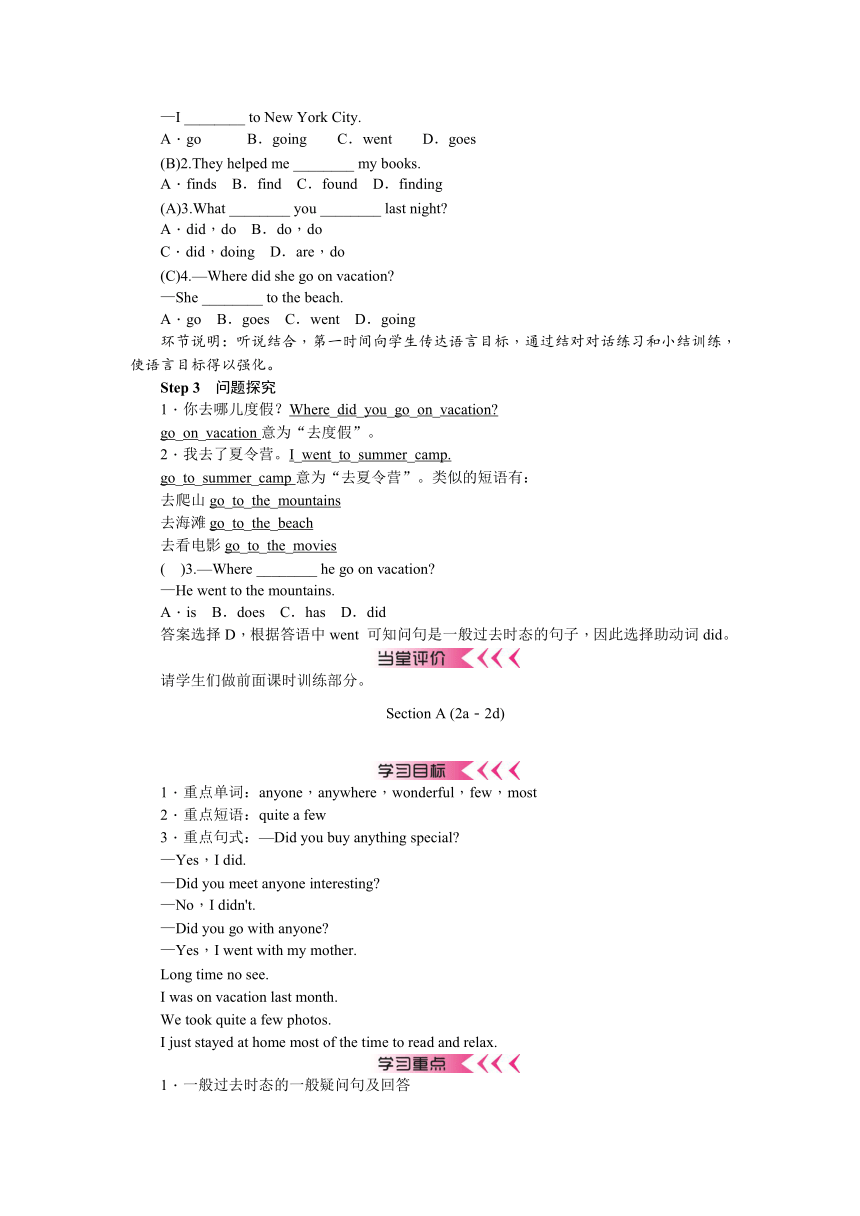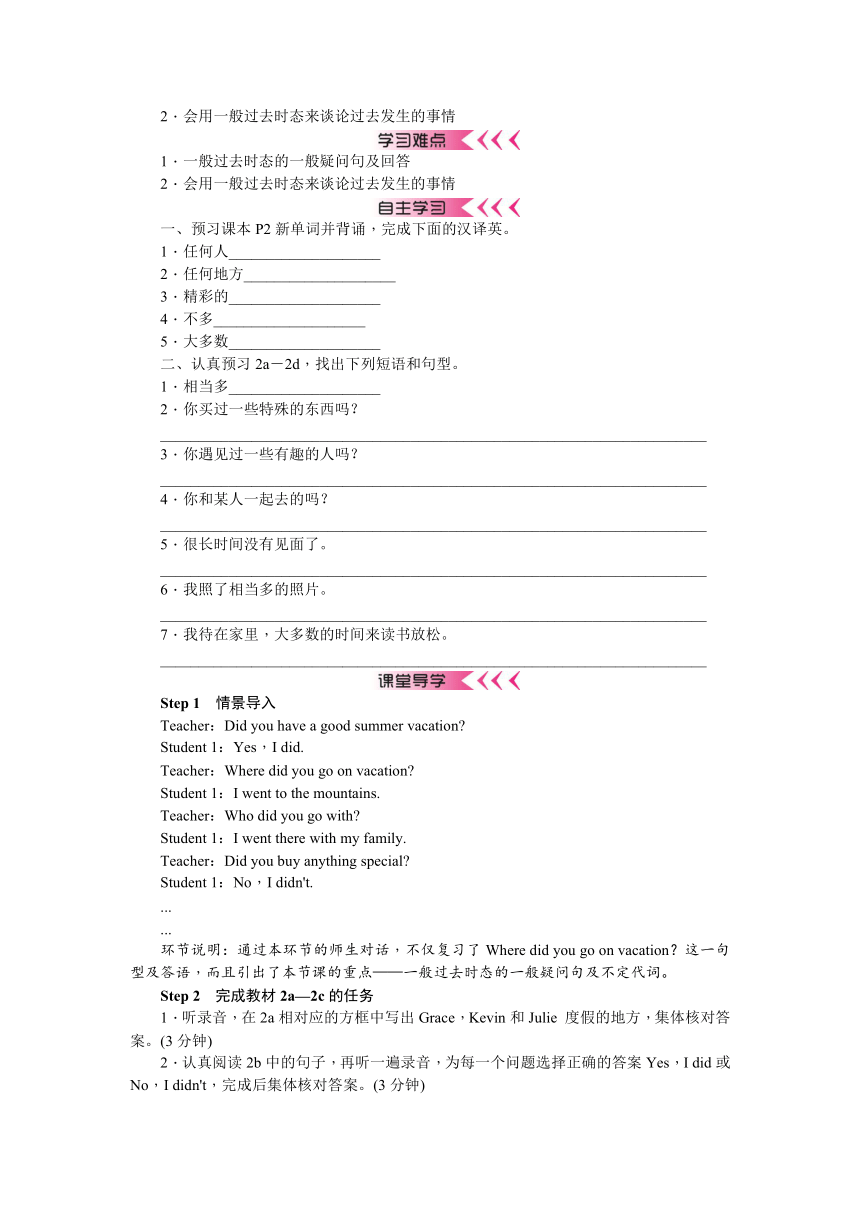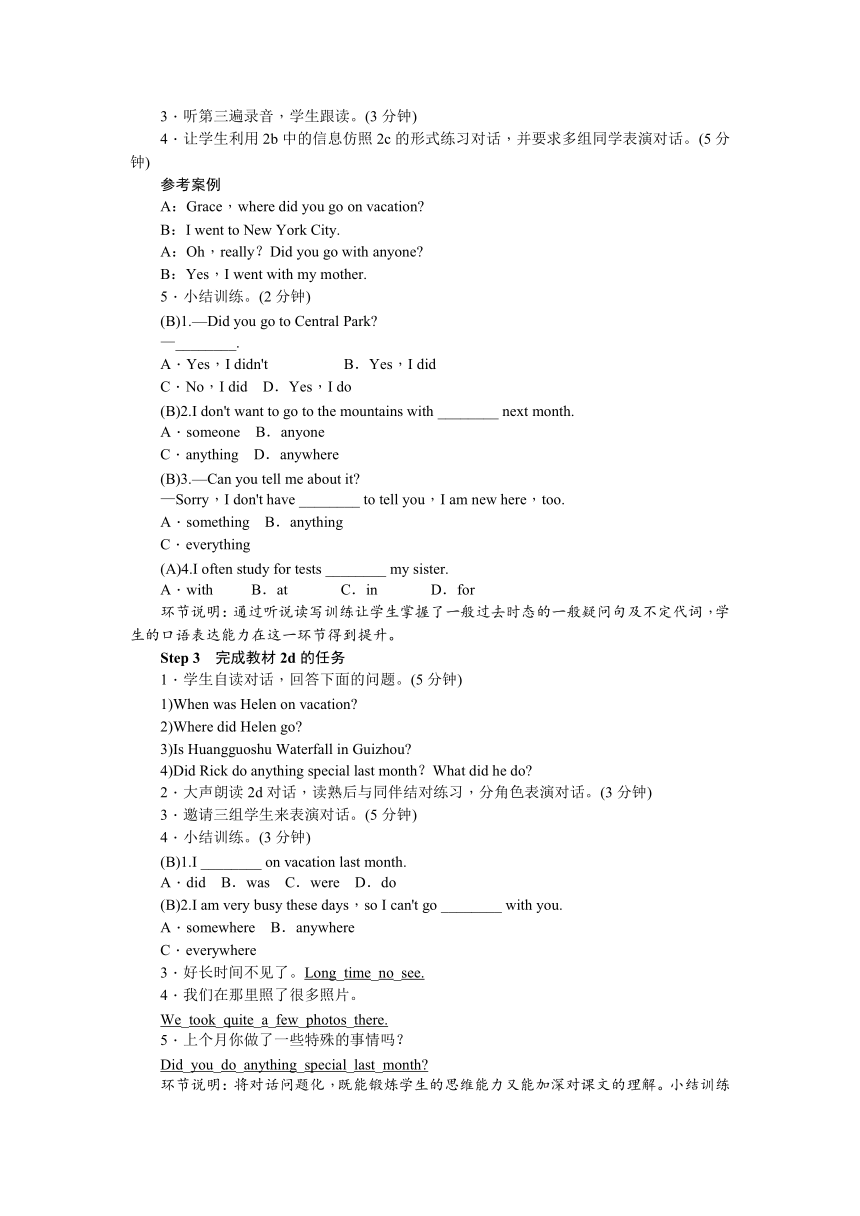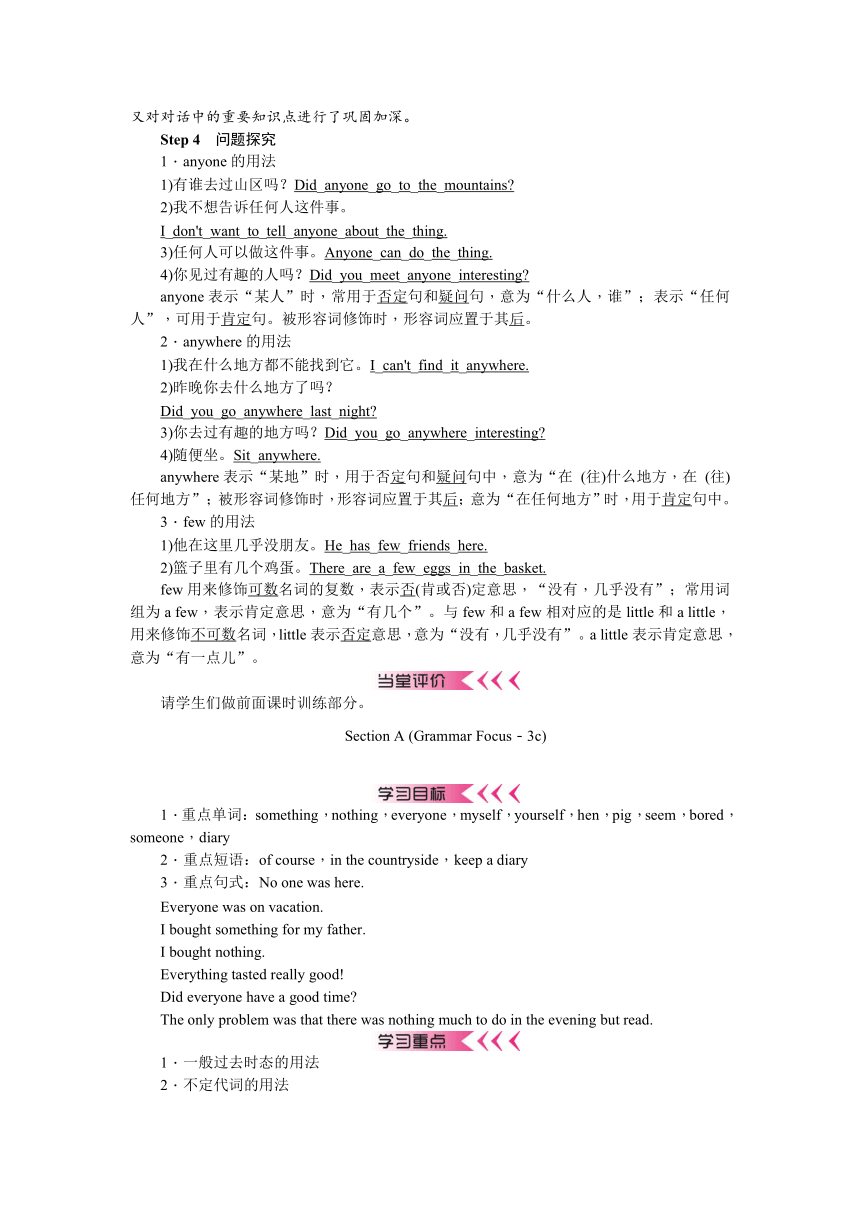Unit 1 Where did you go on vacation?教学设计
文档属性
| 名称 | Unit 1 Where did you go on vacation?教学设计 |  | |
| 格式 | zip | ||
| 文件大小 | 382.1KB | ||
| 资源类型 | 教案 | ||
| 版本资源 | 人教新目标(Go for it)版 | ||
| 科目 | 英语 | ||
| 更新时间 | 2016-10-17 20:06:35 | ||
图片预览





文档简介
Unit
1 Where
did
you
go
on
vacation
Section
A
(1a-1c)
1.重点短语:stay
at
home,go
to
the
mountains,go
to
summer
camp
2.重点句式:—Where
did
Tina
go
on
vacation
—She
went
to
the
mountains.
1.重点短语和句型
2.一般过去时态的特殊疑问句和陈述句
一般过去时态的特殊疑问句和陈述句
一、认真预习1a—1c,找出下列短语和句型。
1.待在家里____________________
2.去山区____________________
3.去夏令营____________________
4.去纽约城____________________
5.—蒂娜去哪里度假了?
________________________________________________________________________
—她去山区了。
________________________________________________________________________
Step
1 情景导入
Teacher:Hello,everyone.Glad
to
see
you
again.Did
you
have
a
good
time
during
the
vacation?Did
you
go
anywhere
interesting
with
your
parents?Did
you
do
anything
special
there?Can
you
tell
us
where
you
went
on
vacation
环节说明:以学生假期旅行为话题开始本节课的教学,引起了学生的学习兴趣和用英语表达的欲望。
Step
2 完成教材1a—1c的任务
1.学生领读1a中的单词和词组,学生识记单词和词组并且将活动和图片中的人物匹配。(3分钟)。
2.认真观察1a图片中的人物活动,然后认真听录音,将1b中的人物序号写在相应的图片旁边,完成课本上1b的听力任务。(3分钟)
3.再听一遍录音,并跟读对话。(2分钟)
4.结对练习1c中的对话,并请一些学生表演出他们的对话。(3分钟)
5.模仿1c中的对话,利用1a中的短语和1b的听力答案与同伴编练新对话,并邀请一些小组表演对话。(5分钟)
参考案例
A:Where
did
Tina
go
on
vacation
B:She
went
to
the
mountains.
6.小结训练。(3分钟)
(C)1.—What
did
you
do
on
vacation
—I
________
to
New
York
City.
A.go B.going C.went D.goes
(B)2.They
helped
me
________
my
books.
A.finds
B.find
C.found
D.finding
(A)3.What
________
you
________
last
night
A.did,do
B.do,do
C.did,doing
D.are,do
(C)4.—Where
did
she
go
on
vacation
—She
________
to
the
beach.
A.go
B.goes
C.went
D.going
环节说明:听说结合,第一时间向学生传达语言目标,通过结对对话练习和小结训练,使语言目标得以强化。
Step
3 问题探究
1.你去哪儿度假?Where_did_you_go_on_vacation
go_on_vacation意为“去度假”。
2.我去了夏令营。I_went_to_summer_camp.
go_to_summer_camp意为“去夏令营”。类似的短语有:
去爬山go_to_the_mountains
去海滩go_to_the_beach
去看电影go_to_the_movies
( )3.—Where
________
he
go
on
vacation
—He
went
to
the
mountains.
A.is
B.does
C.has
D.did
答案选择D,根据答语中went
可知问句是一般过去时态的句子,因此选择助动词did。
请学生们做前面课时训练部分。
Section
A
(2a-2d)
1.重点单词:anyone,anywhere,wonderful,few,most
2.重点短语:quite
a
few
3.重点句式:—Did
you
buy
anything
special
—Yes,I
did.
—Did
you
meet
anyone
interesting
—No,I
didn't.
—Did
you
go
with
anyone
—Yes,I
went
with
my
mother.
Long
time
no
see.
I
was
on
vacation
last
month.
We
took
quite
a
few
photos.
I
just
stayed
at
home
most
of
the
time
to
read
and
relax.
1.一般过去时态的一般疑问句及回答
2.会用一般过去时态来谈论过去发生的事情
1.一般过去时态的一般疑问句及回答
2.会用一般过去时态来谈论过去发生的事情
一、预习课本P2新单词并背诵,完成下面的汉译英。
1.任何人____________________
2.任何地方____________________
3.精彩的____________________
4.不多____________________
5.大多数____________________
二、认真预习2a-2d,找出下列短语和句型。
1.相当多____________________
2.你买过一些特殊的东西吗?
________________________________________________________________________
3.你遇见过一些有趣的人吗?
________________________________________________________________________
4.你和某人一起去的吗?
________________________________________________________________________
5.很长时间没有见面了。
________________________________________________________________________
6.我照了相当多的照片。
________________________________________________________________________
7.我待在家里,大多数的时间来读书放松。
________________________________________________________________________
Step
1 情景导入
Teacher:Did
you
have
a
good
summer
vacation
Student
1:Yes,I
did.
Teacher:Where
did
you
go
on
vacation
Student
1:I
went
to
the
mountains.
Teacher:Who
did
you
go
with
Student
1:I
went
there
with
my
family.
Teacher:Did
you
buy
anything
special
Student
1:No,I
didn't.
...
...
环节说明:通过本环节的师生对话,不仅复习了Where
did
you
go
on
vacation?这一句型及答语,而且引出了本节课的重点——一般过去时态的一般疑问句及不定代词。
Step
2 完成教材2a—2c的任务
1.听录音,在2a相对应的方框中写出Grace,Kevin和Julie
度假的地方,集体核对答案。(3分钟)
2.认真阅读2b中的句子,再听一遍录音,为每一个问题选择正确的答案Yes,I
did或No,I
didn't,完成后集体核对答案。(3分钟)
3.听第三遍录音,学生跟读。(3分钟)
4.让学生利用2b中的信息仿照2c的形式练习对话,并要求多组同学表演对话。(5分钟)
参考案例
A:Grace,where
did
you
go
on
vacation
B:I
went
to
New
York
City.
A:Oh,really?Did
you
go
with
anyone
B:Yes,I
went
with
my
mother.
5.小结训练。(2分钟)
(B)1.—Did
you
go
to
Central
Park
—________.
A.Yes,I
didn't B.Yes,I
did
C.No,I
did
D.Yes,I
do
(B)2.I
don't
want
to
go
to
the
mountains
with
________
next
month.
A.someone
B.anyone
C.anything
D.anywhere
(B)3.—Can
you
tell
me
about
it
—Sorry,I
don't
have
________
to
tell
you,I
am
new
here,too.
A.something
B.anything
C.everything
(A)4.I
often
study
for
tests
________
my
sister.
A.with
B.at
C.in
D.for
环节说明:通过听说读写训练让学生掌握了一般过去时态的一般疑问句及不定代词,学生的口语表达能力在这一环节得到提升。
Step
3 完成教材2d的任务
1.学生自读对话,回答下面的问题。(5分钟)
1)When
was
Helen
on
vacation
2)Where
did
Helen
go
3)Is
Huangguoshu
Waterfall
in
Guizhou
4)Did
Rick
do
anything
special
last
month?What
did
he
do
2.大声朗读2d对话,读熟后与同伴结对练习,分角色表演对话。(3分钟)
3.邀请三组学生来表演对话。(5分钟)
4.小结训练。(3分钟)
(B)1.I
________
on
vacation
last
month.
A.did
B.was
C.were
D.do
(B)2.I
am
very
busy
these
days,so
I
can't
go
________
with
you.
A.somewhere
B.anywhere
C.everywhere
3.好长时间不见了。Long_time_no_see.
4.我们在那里照了很多照片。
We_took_quite_a_few_photos_there.
5.上个月你做了一些特殊的事情吗?
Did_you_do_anything_special_last_month
环节说明:将对话问题化,既能锻炼学生的思维能力又能加深对课文的理解。小结训练又对对话中的重要知识点进行了巩固加深。
Step
4 问题探究
1.anyone的用法
1)有谁去过山区吗?Did_anyone_go_to_the_mountains
2)我不想告诉任何人这件事。
I_don't_want_to_tell_anyone_about_the_thing.
3)任何人可以做这件事。Anyone_can_do_the_thing.
4)你见过有趣的人吗?Did_you_meet_anyone_interesting
anyone表示“某人”时,常用于否定句和疑问句,意为“什么人,谁”;表示“任何人”,可用于肯定句。被形容词修饰时,形容词应置于其后。
2.anywhere的用法
1)我在什么地方都不能找到它。I_can't_find_it_anywhere.
2)昨晚你去什么地方了吗?
Did_you_go_anywhere_last_night
3)你去过有趣的地方吗?Did_you_go_anywhere_interesting
4)随便坐。Sit_anywhere.
anywhere表示“某地”时,用于否定句和疑问句中,意为“在
(往)什么地方,在
(往)任何地方”;被形容词修饰时,形容词应置于其后;意为“在任何地方”时,用于肯定句中。
3.few的用法
1)他在这里几乎没朋友。He_has_few_friends_here.
2)篮子里有几个鸡蛋。There_are_a_few_eggs_in_the_basket.
few用来修饰可数名词的复数,表示否(肯或否)定意思,“没有,几乎没有”;常用词组为a
few,表示肯定意思,意为“有几个”。与few和a
few相对应的是little和a
little,用来修饰不可数名词,little表示否定意思,意为“没有,几乎没有”。a
little表示肯定意思,意为“有一点儿”。
请学生们做前面课时训练部分。
Section
A
(Grammar
Focus-3c)
1.重点单词:something,nothing,everyone,myself,yourself,hen,pig,seem,bored,someone,diary
2.重点短语:of
course,in
the
countryside,keep
a
diary
3.重点句式:No
one
was
here.
Everyone
was
on
vacation.
I
bought
something
for
my
father.
I
bought
nothing.
Everything
tasted
really
good!
Did
everyone
have
a
good
time
The
only
problem
was
that
there
was
nothing
much
to
do
in
the
evening
but
read.
1.一般过去时态的用法
2.不定代词的用法
不定代词的用法
一、预习课本P3新单词并背诵,完成下面的汉译英。
1.某物____________________
2.没有什么____________________
3.你自己____________________
4.母鸡____________________
5.猪____________________
6.好像____________________
7.郁闷的____________________
8.某人____________________
9.日记____________________
二、认真预习Grammar
Focus-3c,找出下列短语和句型。
1.当然____________________
2.在乡下____________________
3.记日记____________________
4.没有人在这儿。
________________________________________________________________________
5.每一个人都去度假了。
________________________________________________________________________
6.我给我爸爸买了些东西。
________________________________________________________________________
7.每一样东西品尝起来都很好。
________________________________________________________________________
8.每一个人都玩得很高兴吗?
________________________________________________________________________
9.唯一的问题就是在晚上没有什么事情可做,只能读书。
________________________________________________________________________
Step
1 情景导入
Teacher:Now,please
listen
to
me
carefully
and
answer
my
questions.I
went
to
Qingdao
last
vacation.I
went
there
with
my
family.It
was
my
first
time
to
go
there,so
everything
was
really
interesting.And
I
bought
something
for
my
friends,but
I
didn't
buy
anything
for
myself.
1)Where
did
I
go
last
vacation
2)Did
I
go
there
with
anyone
3)Did
I
buy
anything
for
myself
环节说明:本环节既练习了学生的听力又复习了所学的知识。
Step
2 完成教材Grammar
Focus的任务
1.学生大声朗读Grammar
Focus的句子。(2分钟)
2.小结训练。(2分钟)
Where_did_you_go_on_vacation?(你去哪度假了?)
I
went
to
New
York
City.
Did_you_go_out_with_anyone?(你和某人一起出去的吗?)
No.No_one
(没有人)
was
here.Everyone
(每一个人)
was
on
vacation.
Did_you_buy_anything_special?(你买了一些特殊的东西吗?)
Yes,I
bought
something
(某物)
for
my
father.
How_was_the_food?(食物怎么样呢?)
Everything_tasted_really_good!(每一样东西品尝起来都很好。)
Did_everyone_have_a_good_time?(每一个人都玩得很高兴吗?)
Oh,yes.Everything_was_excellent.(噢,是的。每一样东西都很棒。)
环节说明:通过对Grammar
Focus句型的填空练习能够使学生更好地来理解掌握本单元重点语法和句型。
Step
3 完成教材3a—3c的任务
1.认真阅读3a对话,从方框中选择合适的不定代词补全对话,完成后集体核对答案,然后两人一组练习对话,并让几组学生表演对话。(5分钟)
2.认真阅读3b的电子邮件,用方框中的不定代词来补全短文,完成后集体核对答案。
然后让学生大声朗读短文。(5分钟)
3.以小组为单位,询问小组其他成员3c中的问题,然后根据调查结果向其他同学汇报结果。
参考案例
In
our
group,everyone
ate
something
at
a
restaurant.And
everyone
read
something
interesting.Tim
and
Mary
visited
someone
in
their
family.Everyone
bought
something.And
no
one
kept
a
diary.
4.小结训练。(4分钟)
(B)1.I
have
________
to
tell
you.
A.anything
interesting
B.something
interesting
C.interesting
anything
D.interesting
something
(B)2.—What
can
you
see
in
the
basket
—I
can
see
________.
A.anything B.nothing C.everything
(C)3.The
light
in
the
room
is
still
on,I
think
________
is
in
the
room.
A.everyone
B.anyone
C.someone
(D)4.The
work
is
very
easy,I
can
do
it
by
________.
A.me
B.my
C.mine D.myself
(A)5.The
TV
show
is
very
,and
I
feel
.
A.boring,bored
B.boring,boring
C.bored,bored
D.bored,boring
(C)6.He
seems
________
after
hard
work.
A.to
tired
B.tire
C.to
be
tired
(A)7.—Can
you
help
me
with
my
English
—________.
A.Of
course
B.You
are
welcome
C.That's
for
sure
环节说明:通过本环节的学习,让学生掌握了不定代词的用法,同时小结训练更是加深了对重要知识点的巩固深化。
Step
4 问题探究
1.由some,any,no,every构成的不定代词的用法
1)有人认识他。Someone_knows_him.
2)有什么有趣的事吗?Is_there_anything_interesting
3)你能给我一些吃的东西吗?
Can_you_give_me_something_to_eat
4)今天的报纸上没有什么新内容。
There_is_nothing_new_on_today's_newspaper.
复合不定代词做主语时都看做单数,其谓语动词用单数形式;复合不定代词被定语所修饰时,定语必须放在它们的后面,由some构成的合成代词一般用于肯定句,由any构成的合成代词一般用于否定句和疑问句。
如果要在疑问句中表示请求、建议等肯定的意思或者盼望得到肯定的答复,须用somebody,someone或something。
2.seem的用法
1)一切似乎很容易。Everything_seems_easy.
2)这道数学题似乎很难。
The_math_problem_seems_to_be_difficult.
3)似乎她很高兴。She_seems_to_be_very_happy.
seem意为“看起来像……,似乎……,好像……”,经常用到的句型是:1)seem+形容词;2)seem+to
do
sth.;3)It
seems
that+句子。
3.boring
与bored的用法区别
1)这部电视剧很无聊。The_TV_play_is_very_boring.
2)我很无聊。I_am_very_bored.
bored和boring是动词bore的两个形容词。bored表示“感到厌烦的”,用来指人;boring表示“令人厌烦的”,指物。
请学生们做前面课时训练部分。
Section
B
(1a-1e)
1.学习掌握有关评价事物的形容词
2.能运用be+形容词来评价事物
3.熟练地谈论表示过去发生的事件
1.能运用be+形容词来评价事物
2.熟练地谈论表示过去发生的事件
1.能运用be+形容词来评价事物
2.熟练地谈论表示过去发生的事件
一、认真预习1a-1e,找出下列句型。
丽莎对她的假期是怎么评价的?
________________________________________________________________________
Step
1 情景导入
Teacher:Now
let's
have
a
dictation.I
will
give
you
the
Chinese
meanings,please
write
them
in
English.
1)一本有趣的书
2)这本书很有趣。
3)这个女孩很漂亮。
4)我弟弟很聪明。……
Now
please
check
the
answers
in
groups.Then
write
some
sentences
like
them.
环节说明:由听写短语或句型过渡到自己写短语或句型,让学生尽可能多地写出学过的形容词,为学习形容词描述事物打下基础。
Step
2 完成教材1a—1b的任务
1.学生领读1a中的形容词,然后两人一组互相提问背诵单词。(3分钟)
2.仔细观察1a图片,将图片和形容词匹配,集体核对答案。(2分钟)
3.再认真地读1a中的单词,然后将这些单词分成两类,将表示积极意义的形容词写在左边的横线上,将表示消极意义的形容词写在右边的横线上,小组内核对答案,完成1b。(2分钟)
4.让学生用这些形容词来写句子,写完后小组内互相交流。(3分钟)
5.小结训练。(2分钟)
1)I
like
Chinese
food
because
it's
delicious.
2)My
computer
isn't
cheap.It's
expensive.
3)The
movie
is
very
boring,I
don't
like
it
at
all.
4)He
tells
us
something
exciting.
环节说明:通过本环节的学习让学生记住了这些形容词,用形容词造句更是让学生掌握了这类词的用法。
Step
3 完成教材1c—1e的任务
1.认真阅读1c中的句子,带着问题听第一遍录音,将问题的答案写在横线上,集体核对答案。(3分钟)
2.再认真听一遍录音,完成1d,集体核对答案。(3分钟)
3.听第三遍录音,并跟读,整体感知对话。(3分钟)
4.利用1c、1d中的信息,用1e中的问题提示两人一组来练习对话,并邀请几组学生表演对话。(5分钟)
参考案例
A:How
was
her
vacation
B:It
was
very
great.
5.小结训练。(3分钟)
(C)1.Did
Vera
________
vacation
A.likes
her
B.like
hers
C.like
her
D.likes
she
(A)2.Where
did
Kim
________
vacation
A.go
on
B.go
in C.go
to D.went
on
(A)3.Jim
is
a
boy
________
brown
hair.
A.with
B.of
C.has
D.in
(B)4.These
books
are
________.Let's
buy
them.
A.expensive
B.cheap
C.crowded
D.delicious
(D)5.Yesterday
we
________
kites.
A.flying
B.is
flying
C.flied
D.flew
Step
4 问题探究
( )1.What
did
they
say
________
the
Great
Wall
A.about
B.to
C.on
D.at
答案选择A,say
about
发表对……的看法。
( )2.Tomorrow
is
my
mother's
birthday.And
I
want
to
buy
a
gift
________
her.
A.about
B.to
C.for
D.with
答案选择C,buy
sth.for
sb.=buy
sb.sth.给某人买某物。
请学生们做前面课时训练部分。
Section
B
(2a-2e)
1.重点单词:activity,decide,try,bird,bicycle,building,trader,wonder,difference,top,wait,umbrella,wet,below,enough,hungry,as
2.重点短语:arrive
in,feel
like,a
lot
of
new
buildings,in
the
past,over
an
hour,because
of,along
the
way,about
an
hour
later,another
two
hours,the
top
of
the
hill
3.重点句式:We
decided
to
go
to
the
beach
near
our
hotel.
I
felt
like
I
was
a
bird.
I
wonder
what
life
was
like
here
in
the
past.
I
really
enjoyed
walking
around
the
town.
What
a
difference
a
day
makes!
It
started
raining
a
little.
And
because
of
the
bad
weather,we
couldn't
see
anything
below.
My
father
didn't
bring
enough
money.
That's
not
all.
1.重点短语和句型
2.会用一般过去时态叙述过去发生的事情
1.重点短语和句型
2.会用一般过去时态叙述过去发生的事情
一、预习课本P5-6新单词并背诵,完成下面的汉译英。
1.活动____________
2.决定____________
3.尝试____________
4.鸟____________
5.自行车____________
6.建筑物____________
7.商人____________
8.想知道____________
9.差别____________
10.顶部____________
11.等待____________
12.雨伞____________
13.潮湿的____________________
14.在……下面____________________
15.足够的____________
16.饥饿____________
17.如同____________
二、认真预习2a-
2e,找出下列短语和句型。
1.到达____________________
2.感觉像……____________________
3.许多新的建筑物____________________
4.在过去____________________
5.一个多小时____________________
6.因为____________________
7.沿途____________________
8.大约一个小时之后
________________________________________________________________________
9.另外两个小时
________________________________________________________________________
10.山顶____________________
11.我们决定去我们旅馆附近的海滩。
________________________________________________________________________
12.我感觉我就像一只小鸟。
________________________________________________________________________
13.我想知道过去的生活是什么样子的。
________________________________________________________________________
14.我真的很喜欢围绕着小镇散步。
________________________________________________________________________
15.多么与众不同的一天呀!
________________________________________________________________________
16.天开始下小雨。
________________________________________________________________________
17.因为糟糕的天气,我们看不到下面的任何东西。
________________________________________________________________________
18.我爸爸没有带足够的钱。
________________________________________________________________________
19.那还不是全部。
________________________________________________________________________
Step
1 情景导入
Teacher:Hello,everyone!Do
you
like
travelling?Have
you
ever
been
to
Malaysia?Do
you
know
Penang
Hill?Jane
went
to
Malaysia
with
her
family.They
had
a
good
time
on
the
first
day,but
the
next
day
is
terrible
for
them.Do
you
want
to
know
what
happened
to
them?OK,let's
read
Jane's
diary
entries
to
see
what
happened
to
them
on
earth.
环节说明:以Jane
的旅游经历为话题,设置悬念,引起学生的好奇心,引出本节课的学习。
Step
2 完成教材2a—2b的任务
1.认真思考2a中的两个问题并在小组内讨论,发表自己的观点。比一比谁说得好。(3分钟)
2.快速的阅读2b中Jane的日记,回答教材中所提出来的两个问题,集体核对答案。(3分钟)
3.认真朗读日记,了解日记内容,理解每一句话的意思,小组合作解决遇到的疑难问题。(5分钟)
4.教师点拨短文中出现的重点和难点。(10分钟)
5.熟读短文,识记背诵知识要点。(5分钟)
6.小结训练。(3分钟)
(A)1.Tomorrow
is
Sunday
and
I
decide
________
my
mother
with
the
housework.
A.to
help
B.help C.helping D.helps
(C)2.I
don't
feel
like
________
now.
A.to
eat
anything
B.eating
something
C.eating
anything
D.eat
anything
(C)3.The
girl
didn't
come
to
school
yesterday
________
her
illness.
A.because
B.so
C.because
of
D.thanks
to
(B)4.The
girl
is
________
a
ticket.
A.enough
tall
buying
B.tall
enough
to
buy
C.tall
enough
buying
D.enough
tall
to
buy
(D)5.There
are
many
________
between
the
twins.
A.different
B.difference
C.differently
D.differences
环节说明:通过本环节的学习使学生不仅了解了旅游日记的写法,而且通过小结训练让学生对重要知识点进行了巩固练习。
Step
3 完成教材2c—2e的任务
1.再次认真阅读日记,根据日记所记录的内容来完成2c表格,集体核对答案。(5分钟)
2.根据Jane去马来西亚旅行的信息来完成2d中Ann和Jane的对话。完成后集体核对答案。然后两人一组练习对话,并邀请两组学生表演对话。(5分钟)
3.认真阅读Jane再次去槟城山的旅行日记,用所给词的正确形式来补全日记,完成后集体核对答案。(5分钟)
4.大声朗读2e日记,体会日记的写法及一般过去时态的用法。(3分钟)
环节说明:这一环节的训练,有助于学生的阅读水平的提高,巩固所学的知识。
5.小结训练。(3分钟)
(C)1.There
are
ten
students,but
we
have
only
five
books,so
we
still
need
________
books.
A.five
another
B.more
five
C.another
five
(B)2.We
don't
have
________
money
for
a
taxi,so
we
have
to
walk
home.
A.some B.any C.few D.anything
(C)3.Two
hours
________,we
got
home.
A.after
B.late
C.later
Step
4 问题探究
1.decide的用法
1)你决定去买一些特殊的东西吗?
Do_you_decide_to_buy_anything_special
2)我决定明天不去打篮球了。
I_decide_not_to_play_basketball_tomorrow.
decide意为“决定”,经常用到的句型:1)决定做某事decide_to_do_sth.;2)决定不做某事decide_not_to_do_sth.。它的名词是decision,常用句型为make_a_decision_to_do_sth.。
2.try的用法
1)试一试have_a_try
2)请尽量在30分钟完成这项工作。
Please_try_to_finish_the_work_in_30_minutes.
3)为什么不试着骑车去学校呢?
Why_not_try_riding_a_bike_to_school
4)我要尽我最大的努力来帮助你。
I_will_try_my_best_to_help_you.
try意为“尝试,努力”,既可以作为动词,也可以作为名词。常用到的句型:1)努力做某事try_to_do_sth.2)尝试做某事try_doing_sth.3)尽某人最大的努力做某事try_one's_best_to_do_sth.。
3.feel
like的用法
1)好像马上就要下雨了。It_feels_like_rain_soon.
2)我现在什么都不想吃。I_feel_like_eating_nothing_now.
3)我感觉我就像一只鸟。I_felt_like_I_was_a_bird.
feel
like+名词意为“觉得好像……”。
feel
like+doing意为“想做……”,其同义句为want_to_do和would_like_to_do。
feel
like+从句,意为“觉得好像是……”。
4.because与because
of的区别
1)我没有买是因为它太贵了。
I_didn't_buy_it_because_it_was_too_expensive.
2)由于年龄关系他失去了工作。
He_lost_his_job_because_of_his_age.
3)他为你而来这里。He_comes_here_because_of_you.
because和because
of的意思都是“因为”,但是because是连词,其后接句子;because
of是复合介词,其后接名词、动名词等。
5.enough的用法
1)我有足够的时间来写作业。
I_have_enough_time_to_do_homework.
2)我们有足够的苹果给每一个人。
We_have_enough_apples_to_give_everyone.
3)这孩子到上学的年龄了。
The_child_is_old_enough_to_go_to_school.
enough用作形容词时,意思是“足够的”,通常用来修饰名词。既可以修饰可数名词也可以修饰不可数名词,可放在该名词之前,也可放在该名词之后;但在enough用作副词时,意为“足够地,充分地,相当地”及“很”
等意思,修饰形容词、副词或动词时,应放在这些词之后。
5.another与more的区别
我需要另外两本书。I_need_another_two_books.或I_need_two_more_books.
another和more都表示“额外又……个”,常用到的结构为:another+数词+复数名词=数词+more+复数名词。
请学生们做前面课时训练部分。
Section
B
(3a)-Self
Check
1.重点单词:duck,dislike
2.重点短语:learn
something
important,in
the
shopping
center,find
out,go
on,come
up
3.重点句式:How
did
you
feel
about
the
trip
Did
you
dislike
anything
I
didn't
bring
back
anything
from
Malaysia.
My
classmates
told
me
to
keep
going.So
I
went
on.
Everyone
jumped
up
and
down
in
excitement.
It
was
so
beautiful
that
we
forgot
about
the
last
five
hours.
1.不定代词的用法
2.用一般过去时态叙述过去发生的事情
1.不定代词的用法
2.用一般过去时态叙述过去发生的事情
一、预习课本P7新单词并背诵,完成下面的汉译英。
1.鸭子____________ 2.不喜欢____________
二、认真预习3a-Self
Check,找出下列短语和句型。
1.学到一些重要的东西
________________________________________________________________________
2.在购物中心
________________________________________________________________________
3.查明
________________________________________________________________________
4.继续
________________________________________________________________________
5.升起来
________________________________________________________________________
6.你感觉这次旅行怎么样?
________________________________________________________________________
7.你不喜欢某些东西吗?
________________________________________________________________________
8.我没有从马来西亚带回来一些东西。
________________________________________________________________________
9.我的同学告诉我要坚持,所以我继续走下去。
________________________________________________________________________
10.每一个人都激动地跳了起来。
________________________________________________________________________
Step
1 情景导入
Teacher:Have
you
ever
been
to
Beijing?There
are
many
famous
places,such
as
Tian'anmen
Square,the
Great
Wall,Beijing
Hutong
and
so
on.Now
please
tell
us
something
about
your
trip
to
visit
the
famous
places
in
Beijing.
环节说明:以旅游为话题,既复习了本单元所学的语言目标又锻炼了学生的口语。
Step
2 完成教材3a—4的任务
1.两人一组大声朗读3a的单词和短语,然后选择合适的单词或短语来补全短文,完成后集体核对答案,并大声地朗读短文。(3分钟)
2.两人一组互相提问3b中的问题,把自己的答案记下来,然后仿照第5页上Jane的日记来写自己的旅行日记,写完后小组内互相交流纠错,教师抽查点评短文,完成3c。(10分钟)
参考案例
Tuesday,July
28th
Today
the
weather
was
very
sunny.I
went
to
Qingdao
with
my
family.I
went
to
the
beach.There
were
many
people
there.Some
people
swam
in
the
sea,some
lay
on
the
beach
to
enjoy
the
sunshine.I
found
many
beautiful
shells
on
the
beach
with
my
sister.I
liked
them
very
much.I
ate
some
sea
food.I
think
it
was
awful.But
my
father
said
it
was
very
delicious.We
stayed
there
for
a
week.I
was
happy
to
stay
here.
3.假如你和你的搭档是在中国度假的外国人,你们在机场相见,然后用我们学过的句型互相询问对方在中国的度假情况。(3分钟)
环节说明:通过这个教学环节让学生复习了日记的写法,完成了本单元的写作,提高了学生的写作水平。
Step
3 完成教材Self
Check的任务
1.请同学们认真阅读1中的对话,然后从左边方框中选择合适的不定代词来补全对话。完成后小组核对答案,然后两人一组练习对话。(5分钟)
2.认真阅读2中的短文,用所给词的正确形式来完成短文,然后集体核对答案,学生大声地朗读短文,弄懂每一句话的意思。(5分钟)
3.教师点拨短文中的知识要点。(3分钟)
环节说明:这一环节通过训练,让学生对本单元的语法——不定代词和一般过去时态有了更深刻的理解。
4.小结训练。(3分钟)
(C)1.Can
you
________
who
broke
the
window
A.look
for B.find C.find
out
(B)2.The
girl
is
________
lovely
that
we
all
like
her.
A.too
B.so
C.very
(C)3.After
a
short
break,we
keep
________.
A.work
B.to
work
C.working
4.The
students
stood
up
and
clapped
in
excitement
(excited).
Step
4 问题探究
1.look
for,find和find
out的区别
1)他在找他的鞋子。He_is_looking_for_his_shoes.
2)他没找到他的自行车。He_didn't_find_his_bike.
3)读这篇短文,找出这个问题的答案。
Read_this_passage,and_find_out_the_answer_to_the_question.
look
for,find和find
out都含有“寻找、找到”的意思,但其含义和用法却不同。
look
for意为“寻找”,是有目的地找,强调“寻找”这一动作。
find意为“找到,发现”,通常指找到或发现具体的东西,也可指偶然发现某物或某种情况,强调的是找的结果。
find
out意为“找出,发现,查明”,多指通过调查、询问、打听、研究之后“搞清楚、弄明白”,通常含有“经过困难曲折”的含义,指找出较难找到的、无形的、抽象的东西。
2.so...that...的用法
1)天气如此晴朗以至于我想去游泳。
It's_so_sunny_that_I_want_to_swim.
2)他跑得如此快以至于我不能追上他。
He_runs_so_quickly_that_I_can't_catch_up_with_him.
so+形容词或副词+that引导的肯定的结果状语从句,意思是“如此……以至于……”。
so+形容词或副词+that引导的否定的结果状语从句,意思是“如此……以至于不能……”。
当that引导的结果状语从句为肯定句时,so...that...可以与be...enough
to
do转换;当从句为否定句时,可以与too...to...或be
not...enough
to
do转换。
3.keep的用法
1)保暖keep_warm
2)保持教室的整洁keep+the_classroom_tidy
3)他整天都在不停地工作,因为他想准时完成工作。
He_keeps_working_all_day,because_he_wants_to_finish_the_work_on_time.
keep意为“保持”,经常用到的句型为:1)保持某种状态keep+形容词;
2)使……保持某种(状态、位置或动作等)keep...+形容词;
3)继续干某事,表示不间断地持续干某事keep_doing。
请学生们做前面课时训练部分。
1 Where
did
you
go
on
vacation
Section
A
(1a-1c)
1.重点短语:stay
at
home,go
to
the
mountains,go
to
summer
camp
2.重点句式:—Where
did
Tina
go
on
vacation
—She
went
to
the
mountains.
1.重点短语和句型
2.一般过去时态的特殊疑问句和陈述句
一般过去时态的特殊疑问句和陈述句
一、认真预习1a—1c,找出下列短语和句型。
1.待在家里____________________
2.去山区____________________
3.去夏令营____________________
4.去纽约城____________________
5.—蒂娜去哪里度假了?
________________________________________________________________________
—她去山区了。
________________________________________________________________________
Step
1 情景导入
Teacher:Hello,everyone.Glad
to
see
you
again.Did
you
have
a
good
time
during
the
vacation?Did
you
go
anywhere
interesting
with
your
parents?Did
you
do
anything
special
there?Can
you
tell
us
where
you
went
on
vacation
环节说明:以学生假期旅行为话题开始本节课的教学,引起了学生的学习兴趣和用英语表达的欲望。
Step
2 完成教材1a—1c的任务
1.学生领读1a中的单词和词组,学生识记单词和词组并且将活动和图片中的人物匹配。(3分钟)。
2.认真观察1a图片中的人物活动,然后认真听录音,将1b中的人物序号写在相应的图片旁边,完成课本上1b的听力任务。(3分钟)
3.再听一遍录音,并跟读对话。(2分钟)
4.结对练习1c中的对话,并请一些学生表演出他们的对话。(3分钟)
5.模仿1c中的对话,利用1a中的短语和1b的听力答案与同伴编练新对话,并邀请一些小组表演对话。(5分钟)
参考案例
A:Where
did
Tina
go
on
vacation
B:She
went
to
the
mountains.
6.小结训练。(3分钟)
(C)1.—What
did
you
do
on
vacation
—I
________
to
New
York
City.
A.go B.going C.went D.goes
(B)2.They
helped
me
________
my
books.
A.finds
B.find
C.found
D.finding
(A)3.What
________
you
________
last
night
A.did,do
B.do,do
C.did,doing
D.are,do
(C)4.—Where
did
she
go
on
vacation
—She
________
to
the
beach.
A.go
B.goes
C.went
D.going
环节说明:听说结合,第一时间向学生传达语言目标,通过结对对话练习和小结训练,使语言目标得以强化。
Step
3 问题探究
1.你去哪儿度假?Where_did_you_go_on_vacation
go_on_vacation意为“去度假”。
2.我去了夏令营。I_went_to_summer_camp.
go_to_summer_camp意为“去夏令营”。类似的短语有:
去爬山go_to_the_mountains
去海滩go_to_the_beach
去看电影go_to_the_movies
( )3.—Where
________
he
go
on
vacation
—He
went
to
the
mountains.
A.is
B.does
C.has
D.did
答案选择D,根据答语中went
可知问句是一般过去时态的句子,因此选择助动词did。
请学生们做前面课时训练部分。
Section
A
(2a-2d)
1.重点单词:anyone,anywhere,wonderful,few,most
2.重点短语:quite
a
few
3.重点句式:—Did
you
buy
anything
special
—Yes,I
did.
—Did
you
meet
anyone
interesting
—No,I
didn't.
—Did
you
go
with
anyone
—Yes,I
went
with
my
mother.
Long
time
no
see.
I
was
on
vacation
last
month.
We
took
quite
a
few
photos.
I
just
stayed
at
home
most
of
the
time
to
read
and
relax.
1.一般过去时态的一般疑问句及回答
2.会用一般过去时态来谈论过去发生的事情
1.一般过去时态的一般疑问句及回答
2.会用一般过去时态来谈论过去发生的事情
一、预习课本P2新单词并背诵,完成下面的汉译英。
1.任何人____________________
2.任何地方____________________
3.精彩的____________________
4.不多____________________
5.大多数____________________
二、认真预习2a-2d,找出下列短语和句型。
1.相当多____________________
2.你买过一些特殊的东西吗?
________________________________________________________________________
3.你遇见过一些有趣的人吗?
________________________________________________________________________
4.你和某人一起去的吗?
________________________________________________________________________
5.很长时间没有见面了。
________________________________________________________________________
6.我照了相当多的照片。
________________________________________________________________________
7.我待在家里,大多数的时间来读书放松。
________________________________________________________________________
Step
1 情景导入
Teacher:Did
you
have
a
good
summer
vacation
Student
1:Yes,I
did.
Teacher:Where
did
you
go
on
vacation
Student
1:I
went
to
the
mountains.
Teacher:Who
did
you
go
with
Student
1:I
went
there
with
my
family.
Teacher:Did
you
buy
anything
special
Student
1:No,I
didn't.
...
...
环节说明:通过本环节的师生对话,不仅复习了Where
did
you
go
on
vacation?这一句型及答语,而且引出了本节课的重点——一般过去时态的一般疑问句及不定代词。
Step
2 完成教材2a—2c的任务
1.听录音,在2a相对应的方框中写出Grace,Kevin和Julie
度假的地方,集体核对答案。(3分钟)
2.认真阅读2b中的句子,再听一遍录音,为每一个问题选择正确的答案Yes,I
did或No,I
didn't,完成后集体核对答案。(3分钟)
3.听第三遍录音,学生跟读。(3分钟)
4.让学生利用2b中的信息仿照2c的形式练习对话,并要求多组同学表演对话。(5分钟)
参考案例
A:Grace,where
did
you
go
on
vacation
B:I
went
to
New
York
City.
A:Oh,really?Did
you
go
with
anyone
B:Yes,I
went
with
my
mother.
5.小结训练。(2分钟)
(B)1.—Did
you
go
to
Central
Park
—________.
A.Yes,I
didn't B.Yes,I
did
C.No,I
did
D.Yes,I
do
(B)2.I
don't
want
to
go
to
the
mountains
with
________
next
month.
A.someone
B.anyone
C.anything
D.anywhere
(B)3.—Can
you
tell
me
about
it
—Sorry,I
don't
have
________
to
tell
you,I
am
new
here,too.
A.something
B.anything
C.everything
(A)4.I
often
study
for
tests
________
my
sister.
A.with
B.at
C.in
D.for
环节说明:通过听说读写训练让学生掌握了一般过去时态的一般疑问句及不定代词,学生的口语表达能力在这一环节得到提升。
Step
3 完成教材2d的任务
1.学生自读对话,回答下面的问题。(5分钟)
1)When
was
Helen
on
vacation
2)Where
did
Helen
go
3)Is
Huangguoshu
Waterfall
in
Guizhou
4)Did
Rick
do
anything
special
last
month?What
did
he
do
2.大声朗读2d对话,读熟后与同伴结对练习,分角色表演对话。(3分钟)
3.邀请三组学生来表演对话。(5分钟)
4.小结训练。(3分钟)
(B)1.I
________
on
vacation
last
month.
A.did
B.was
C.were
D.do
(B)2.I
am
very
busy
these
days,so
I
can't
go
________
with
you.
A.somewhere
B.anywhere
C.everywhere
3.好长时间不见了。Long_time_no_see.
4.我们在那里照了很多照片。
We_took_quite_a_few_photos_there.
5.上个月你做了一些特殊的事情吗?
Did_you_do_anything_special_last_month
环节说明:将对话问题化,既能锻炼学生的思维能力又能加深对课文的理解。小结训练又对对话中的重要知识点进行了巩固加深。
Step
4 问题探究
1.anyone的用法
1)有谁去过山区吗?Did_anyone_go_to_the_mountains
2)我不想告诉任何人这件事。
I_don't_want_to_tell_anyone_about_the_thing.
3)任何人可以做这件事。Anyone_can_do_the_thing.
4)你见过有趣的人吗?Did_you_meet_anyone_interesting
anyone表示“某人”时,常用于否定句和疑问句,意为“什么人,谁”;表示“任何人”,可用于肯定句。被形容词修饰时,形容词应置于其后。
2.anywhere的用法
1)我在什么地方都不能找到它。I_can't_find_it_anywhere.
2)昨晚你去什么地方了吗?
Did_you_go_anywhere_last_night
3)你去过有趣的地方吗?Did_you_go_anywhere_interesting
4)随便坐。Sit_anywhere.
anywhere表示“某地”时,用于否定句和疑问句中,意为“在
(往)什么地方,在
(往)任何地方”;被形容词修饰时,形容词应置于其后;意为“在任何地方”时,用于肯定句中。
3.few的用法
1)他在这里几乎没朋友。He_has_few_friends_here.
2)篮子里有几个鸡蛋。There_are_a_few_eggs_in_the_basket.
few用来修饰可数名词的复数,表示否(肯或否)定意思,“没有,几乎没有”;常用词组为a
few,表示肯定意思,意为“有几个”。与few和a
few相对应的是little和a
little,用来修饰不可数名词,little表示否定意思,意为“没有,几乎没有”。a
little表示肯定意思,意为“有一点儿”。
请学生们做前面课时训练部分。
Section
A
(Grammar
Focus-3c)
1.重点单词:something,nothing,everyone,myself,yourself,hen,pig,seem,bored,someone,diary
2.重点短语:of
course,in
the
countryside,keep
a
diary
3.重点句式:No
one
was
here.
Everyone
was
on
vacation.
I
bought
something
for
my
father.
I
bought
nothing.
Everything
tasted
really
good!
Did
everyone
have
a
good
time
The
only
problem
was
that
there
was
nothing
much
to
do
in
the
evening
but
read.
1.一般过去时态的用法
2.不定代词的用法
不定代词的用法
一、预习课本P3新单词并背诵,完成下面的汉译英。
1.某物____________________
2.没有什么____________________
3.你自己____________________
4.母鸡____________________
5.猪____________________
6.好像____________________
7.郁闷的____________________
8.某人____________________
9.日记____________________
二、认真预习Grammar
Focus-3c,找出下列短语和句型。
1.当然____________________
2.在乡下____________________
3.记日记____________________
4.没有人在这儿。
________________________________________________________________________
5.每一个人都去度假了。
________________________________________________________________________
6.我给我爸爸买了些东西。
________________________________________________________________________
7.每一样东西品尝起来都很好。
________________________________________________________________________
8.每一个人都玩得很高兴吗?
________________________________________________________________________
9.唯一的问题就是在晚上没有什么事情可做,只能读书。
________________________________________________________________________
Step
1 情景导入
Teacher:Now,please
listen
to
me
carefully
and
answer
my
questions.I
went
to
Qingdao
last
vacation.I
went
there
with
my
family.It
was
my
first
time
to
go
there,so
everything
was
really
interesting.And
I
bought
something
for
my
friends,but
I
didn't
buy
anything
for
myself.
1)Where
did
I
go
last
vacation
2)Did
I
go
there
with
anyone
3)Did
I
buy
anything
for
myself
环节说明:本环节既练习了学生的听力又复习了所学的知识。
Step
2 完成教材Grammar
Focus的任务
1.学生大声朗读Grammar
Focus的句子。(2分钟)
2.小结训练。(2分钟)
Where_did_you_go_on_vacation?(你去哪度假了?)
I
went
to
New
York
City.
Did_you_go_out_with_anyone?(你和某人一起出去的吗?)
No.No_one
(没有人)
was
here.Everyone
(每一个人)
was
on
vacation.
Did_you_buy_anything_special?(你买了一些特殊的东西吗?)
Yes,I
bought
something
(某物)
for
my
father.
How_was_the_food?(食物怎么样呢?)
Everything_tasted_really_good!(每一样东西品尝起来都很好。)
Did_everyone_have_a_good_time?(每一个人都玩得很高兴吗?)
Oh,yes.Everything_was_excellent.(噢,是的。每一样东西都很棒。)
环节说明:通过对Grammar
Focus句型的填空练习能够使学生更好地来理解掌握本单元重点语法和句型。
Step
3 完成教材3a—3c的任务
1.认真阅读3a对话,从方框中选择合适的不定代词补全对话,完成后集体核对答案,然后两人一组练习对话,并让几组学生表演对话。(5分钟)
2.认真阅读3b的电子邮件,用方框中的不定代词来补全短文,完成后集体核对答案。
然后让学生大声朗读短文。(5分钟)
3.以小组为单位,询问小组其他成员3c中的问题,然后根据调查结果向其他同学汇报结果。
参考案例
In
our
group,everyone
ate
something
at
a
restaurant.And
everyone
read
something
interesting.Tim
and
Mary
visited
someone
in
their
family.Everyone
bought
something.And
no
one
kept
a
diary.
4.小结训练。(4分钟)
(B)1.I
have
________
to
tell
you.
A.anything
interesting
B.something
interesting
C.interesting
anything
D.interesting
something
(B)2.—What
can
you
see
in
the
basket
—I
can
see
________.
A.anything B.nothing C.everything
(C)3.The
light
in
the
room
is
still
on,I
think
________
is
in
the
room.
A.everyone
B.anyone
C.someone
(D)4.The
work
is
very
easy,I
can
do
it
by
________.
A.me
B.my
C.mine D.myself
(A)5.The
TV
show
is
very
,and
I
feel
.
A.boring,bored
B.boring,boring
C.bored,bored
D.bored,boring
(C)6.He
seems
________
after
hard
work.
A.to
tired
B.tire
C.to
be
tired
(A)7.—Can
you
help
me
with
my
English
—________.
A.Of
course
B.You
are
welcome
C.That's
for
sure
环节说明:通过本环节的学习,让学生掌握了不定代词的用法,同时小结训练更是加深了对重要知识点的巩固深化。
Step
4 问题探究
1.由some,any,no,every构成的不定代词的用法
1)有人认识他。Someone_knows_him.
2)有什么有趣的事吗?Is_there_anything_interesting
3)你能给我一些吃的东西吗?
Can_you_give_me_something_to_eat
4)今天的报纸上没有什么新内容。
There_is_nothing_new_on_today's_newspaper.
复合不定代词做主语时都看做单数,其谓语动词用单数形式;复合不定代词被定语所修饰时,定语必须放在它们的后面,由some构成的合成代词一般用于肯定句,由any构成的合成代词一般用于否定句和疑问句。
如果要在疑问句中表示请求、建议等肯定的意思或者盼望得到肯定的答复,须用somebody,someone或something。
2.seem的用法
1)一切似乎很容易。Everything_seems_easy.
2)这道数学题似乎很难。
The_math_problem_seems_to_be_difficult.
3)似乎她很高兴。She_seems_to_be_very_happy.
seem意为“看起来像……,似乎……,好像……”,经常用到的句型是:1)seem+形容词;2)seem+to
do
sth.;3)It
seems
that+句子。
3.boring
与bored的用法区别
1)这部电视剧很无聊。The_TV_play_is_very_boring.
2)我很无聊。I_am_very_bored.
bored和boring是动词bore的两个形容词。bored表示“感到厌烦的”,用来指人;boring表示“令人厌烦的”,指物。
请学生们做前面课时训练部分。
Section
B
(1a-1e)
1.学习掌握有关评价事物的形容词
2.能运用be+形容词来评价事物
3.熟练地谈论表示过去发生的事件
1.能运用be+形容词来评价事物
2.熟练地谈论表示过去发生的事件
1.能运用be+形容词来评价事物
2.熟练地谈论表示过去发生的事件
一、认真预习1a-1e,找出下列句型。
丽莎对她的假期是怎么评价的?
________________________________________________________________________
Step
1 情景导入
Teacher:Now
let's
have
a
dictation.I
will
give
you
the
Chinese
meanings,please
write
them
in
English.
1)一本有趣的书
2)这本书很有趣。
3)这个女孩很漂亮。
4)我弟弟很聪明。……
Now
please
check
the
answers
in
groups.Then
write
some
sentences
like
them.
环节说明:由听写短语或句型过渡到自己写短语或句型,让学生尽可能多地写出学过的形容词,为学习形容词描述事物打下基础。
Step
2 完成教材1a—1b的任务
1.学生领读1a中的形容词,然后两人一组互相提问背诵单词。(3分钟)
2.仔细观察1a图片,将图片和形容词匹配,集体核对答案。(2分钟)
3.再认真地读1a中的单词,然后将这些单词分成两类,将表示积极意义的形容词写在左边的横线上,将表示消极意义的形容词写在右边的横线上,小组内核对答案,完成1b。(2分钟)
4.让学生用这些形容词来写句子,写完后小组内互相交流。(3分钟)
5.小结训练。(2分钟)
1)I
like
Chinese
food
because
it's
delicious.
2)My
computer
isn't
cheap.It's
expensive.
3)The
movie
is
very
boring,I
don't
like
it
at
all.
4)He
tells
us
something
exciting.
环节说明:通过本环节的学习让学生记住了这些形容词,用形容词造句更是让学生掌握了这类词的用法。
Step
3 完成教材1c—1e的任务
1.认真阅读1c中的句子,带着问题听第一遍录音,将问题的答案写在横线上,集体核对答案。(3分钟)
2.再认真听一遍录音,完成1d,集体核对答案。(3分钟)
3.听第三遍录音,并跟读,整体感知对话。(3分钟)
4.利用1c、1d中的信息,用1e中的问题提示两人一组来练习对话,并邀请几组学生表演对话。(5分钟)
参考案例
A:How
was
her
vacation
B:It
was
very
great.
5.小结训练。(3分钟)
(C)1.Did
Vera
________
vacation
A.likes
her
B.like
hers
C.like
her
D.likes
she
(A)2.Where
did
Kim
________
vacation
A.go
on
B.go
in C.go
to D.went
on
(A)3.Jim
is
a
boy
________
brown
hair.
A.with
B.of
C.has
D.in
(B)4.These
books
are
________.Let's
buy
them.
A.expensive
B.cheap
C.crowded
D.delicious
(D)5.Yesterday
we
________
kites.
A.flying
B.is
flying
C.flied
D.flew
Step
4 问题探究
( )1.What
did
they
say
________
the
Great
Wall
A.about
B.to
C.on
D.at
答案选择A,say
about
发表对……的看法。
( )2.Tomorrow
is
my
mother's
birthday.And
I
want
to
buy
a
gift
________
her.
A.about
B.to
C.for
D.with
答案选择C,buy
sth.for
sb.=buy
sb.sth.给某人买某物。
请学生们做前面课时训练部分。
Section
B
(2a-2e)
1.重点单词:activity,decide,try,bird,bicycle,building,trader,wonder,difference,top,wait,umbrella,wet,below,enough,hungry,as
2.重点短语:arrive
in,feel
like,a
lot
of
new
buildings,in
the
past,over
an
hour,because
of,along
the
way,about
an
hour
later,another
two
hours,the
top
of
the
hill
3.重点句式:We
decided
to
go
to
the
beach
near
our
hotel.
I
felt
like
I
was
a
bird.
I
wonder
what
life
was
like
here
in
the
past.
I
really
enjoyed
walking
around
the
town.
What
a
difference
a
day
makes!
It
started
raining
a
little.
And
because
of
the
bad
weather,we
couldn't
see
anything
below.
My
father
didn't
bring
enough
money.
That's
not
all.
1.重点短语和句型
2.会用一般过去时态叙述过去发生的事情
1.重点短语和句型
2.会用一般过去时态叙述过去发生的事情
一、预习课本P5-6新单词并背诵,完成下面的汉译英。
1.活动____________
2.决定____________
3.尝试____________
4.鸟____________
5.自行车____________
6.建筑物____________
7.商人____________
8.想知道____________
9.差别____________
10.顶部____________
11.等待____________
12.雨伞____________
13.潮湿的____________________
14.在……下面____________________
15.足够的____________
16.饥饿____________
17.如同____________
二、认真预习2a-
2e,找出下列短语和句型。
1.到达____________________
2.感觉像……____________________
3.许多新的建筑物____________________
4.在过去____________________
5.一个多小时____________________
6.因为____________________
7.沿途____________________
8.大约一个小时之后
________________________________________________________________________
9.另外两个小时
________________________________________________________________________
10.山顶____________________
11.我们决定去我们旅馆附近的海滩。
________________________________________________________________________
12.我感觉我就像一只小鸟。
________________________________________________________________________
13.我想知道过去的生活是什么样子的。
________________________________________________________________________
14.我真的很喜欢围绕着小镇散步。
________________________________________________________________________
15.多么与众不同的一天呀!
________________________________________________________________________
16.天开始下小雨。
________________________________________________________________________
17.因为糟糕的天气,我们看不到下面的任何东西。
________________________________________________________________________
18.我爸爸没有带足够的钱。
________________________________________________________________________
19.那还不是全部。
________________________________________________________________________
Step
1 情景导入
Teacher:Hello,everyone!Do
you
like
travelling?Have
you
ever
been
to
Malaysia?Do
you
know
Penang
Hill?Jane
went
to
Malaysia
with
her
family.They
had
a
good
time
on
the
first
day,but
the
next
day
is
terrible
for
them.Do
you
want
to
know
what
happened
to
them?OK,let's
read
Jane's
diary
entries
to
see
what
happened
to
them
on
earth.
环节说明:以Jane
的旅游经历为话题,设置悬念,引起学生的好奇心,引出本节课的学习。
Step
2 完成教材2a—2b的任务
1.认真思考2a中的两个问题并在小组内讨论,发表自己的观点。比一比谁说得好。(3分钟)
2.快速的阅读2b中Jane的日记,回答教材中所提出来的两个问题,集体核对答案。(3分钟)
3.认真朗读日记,了解日记内容,理解每一句话的意思,小组合作解决遇到的疑难问题。(5分钟)
4.教师点拨短文中出现的重点和难点。(10分钟)
5.熟读短文,识记背诵知识要点。(5分钟)
6.小结训练。(3分钟)
(A)1.Tomorrow
is
Sunday
and
I
decide
________
my
mother
with
the
housework.
A.to
help
B.help C.helping D.helps
(C)2.I
don't
feel
like
________
now.
A.to
eat
anything
B.eating
something
C.eating
anything
D.eat
anything
(C)3.The
girl
didn't
come
to
school
yesterday
________
her
illness.
A.because
B.so
C.because
of
D.thanks
to
(B)4.The
girl
is
________
a
ticket.
A.enough
tall
buying
B.tall
enough
to
buy
C.tall
enough
buying
D.enough
tall
to
buy
(D)5.There
are
many
________
between
the
twins.
A.different
B.difference
C.differently
D.differences
环节说明:通过本环节的学习使学生不仅了解了旅游日记的写法,而且通过小结训练让学生对重要知识点进行了巩固练习。
Step
3 完成教材2c—2e的任务
1.再次认真阅读日记,根据日记所记录的内容来完成2c表格,集体核对答案。(5分钟)
2.根据Jane去马来西亚旅行的信息来完成2d中Ann和Jane的对话。完成后集体核对答案。然后两人一组练习对话,并邀请两组学生表演对话。(5分钟)
3.认真阅读Jane再次去槟城山的旅行日记,用所给词的正确形式来补全日记,完成后集体核对答案。(5分钟)
4.大声朗读2e日记,体会日记的写法及一般过去时态的用法。(3分钟)
环节说明:这一环节的训练,有助于学生的阅读水平的提高,巩固所学的知识。
5.小结训练。(3分钟)
(C)1.There
are
ten
students,but
we
have
only
five
books,so
we
still
need
________
books.
A.five
another
B.more
five
C.another
five
(B)2.We
don't
have
________
money
for
a
taxi,so
we
have
to
walk
home.
A.some B.any C.few D.anything
(C)3.Two
hours
________,we
got
home.
A.after
B.late
C.later
Step
4 问题探究
1.decide的用法
1)你决定去买一些特殊的东西吗?
Do_you_decide_to_buy_anything_special
2)我决定明天不去打篮球了。
I_decide_not_to_play_basketball_tomorrow.
decide意为“决定”,经常用到的句型:1)决定做某事decide_to_do_sth.;2)决定不做某事decide_not_to_do_sth.。它的名词是decision,常用句型为make_a_decision_to_do_sth.。
2.try的用法
1)试一试have_a_try
2)请尽量在30分钟完成这项工作。
Please_try_to_finish_the_work_in_30_minutes.
3)为什么不试着骑车去学校呢?
Why_not_try_riding_a_bike_to_school
4)我要尽我最大的努力来帮助你。
I_will_try_my_best_to_help_you.
try意为“尝试,努力”,既可以作为动词,也可以作为名词。常用到的句型:1)努力做某事try_to_do_sth.2)尝试做某事try_doing_sth.3)尽某人最大的努力做某事try_one's_best_to_do_sth.。
3.feel
like的用法
1)好像马上就要下雨了。It_feels_like_rain_soon.
2)我现在什么都不想吃。I_feel_like_eating_nothing_now.
3)我感觉我就像一只鸟。I_felt_like_I_was_a_bird.
feel
like+名词意为“觉得好像……”。
feel
like+doing意为“想做……”,其同义句为want_to_do和would_like_to_do。
feel
like+从句,意为“觉得好像是……”。
4.because与because
of的区别
1)我没有买是因为它太贵了。
I_didn't_buy_it_because_it_was_too_expensive.
2)由于年龄关系他失去了工作。
He_lost_his_job_because_of_his_age.
3)他为你而来这里。He_comes_here_because_of_you.
because和because
of的意思都是“因为”,但是because是连词,其后接句子;because
of是复合介词,其后接名词、动名词等。
5.enough的用法
1)我有足够的时间来写作业。
I_have_enough_time_to_do_homework.
2)我们有足够的苹果给每一个人。
We_have_enough_apples_to_give_everyone.
3)这孩子到上学的年龄了。
The_child_is_old_enough_to_go_to_school.
enough用作形容词时,意思是“足够的”,通常用来修饰名词。既可以修饰可数名词也可以修饰不可数名词,可放在该名词之前,也可放在该名词之后;但在enough用作副词时,意为“足够地,充分地,相当地”及“很”
等意思,修饰形容词、副词或动词时,应放在这些词之后。
5.another与more的区别
我需要另外两本书。I_need_another_two_books.或I_need_two_more_books.
another和more都表示“额外又……个”,常用到的结构为:another+数词+复数名词=数词+more+复数名词。
请学生们做前面课时训练部分。
Section
B
(3a)-Self
Check
1.重点单词:duck,dislike
2.重点短语:learn
something
important,in
the
shopping
center,find
out,go
on,come
up
3.重点句式:How
did
you
feel
about
the
trip
Did
you
dislike
anything
I
didn't
bring
back
anything
from
Malaysia.
My
classmates
told
me
to
keep
going.So
I
went
on.
Everyone
jumped
up
and
down
in
excitement.
It
was
so
beautiful
that
we
forgot
about
the
last
five
hours.
1.不定代词的用法
2.用一般过去时态叙述过去发生的事情
1.不定代词的用法
2.用一般过去时态叙述过去发生的事情
一、预习课本P7新单词并背诵,完成下面的汉译英。
1.鸭子____________ 2.不喜欢____________
二、认真预习3a-Self
Check,找出下列短语和句型。
1.学到一些重要的东西
________________________________________________________________________
2.在购物中心
________________________________________________________________________
3.查明
________________________________________________________________________
4.继续
________________________________________________________________________
5.升起来
________________________________________________________________________
6.你感觉这次旅行怎么样?
________________________________________________________________________
7.你不喜欢某些东西吗?
________________________________________________________________________
8.我没有从马来西亚带回来一些东西。
________________________________________________________________________
9.我的同学告诉我要坚持,所以我继续走下去。
________________________________________________________________________
10.每一个人都激动地跳了起来。
________________________________________________________________________
Step
1 情景导入
Teacher:Have
you
ever
been
to
Beijing?There
are
many
famous
places,such
as
Tian'anmen
Square,the
Great
Wall,Beijing
Hutong
and
so
on.Now
please
tell
us
something
about
your
trip
to
visit
the
famous
places
in
Beijing.
环节说明:以旅游为话题,既复习了本单元所学的语言目标又锻炼了学生的口语。
Step
2 完成教材3a—4的任务
1.两人一组大声朗读3a的单词和短语,然后选择合适的单词或短语来补全短文,完成后集体核对答案,并大声地朗读短文。(3分钟)
2.两人一组互相提问3b中的问题,把自己的答案记下来,然后仿照第5页上Jane的日记来写自己的旅行日记,写完后小组内互相交流纠错,教师抽查点评短文,完成3c。(10分钟)
参考案例
Tuesday,July
28th
Today
the
weather
was
very
sunny.I
went
to
Qingdao
with
my
family.I
went
to
the
beach.There
were
many
people
there.Some
people
swam
in
the
sea,some
lay
on
the
beach
to
enjoy
the
sunshine.I
found
many
beautiful
shells
on
the
beach
with
my
sister.I
liked
them
very
much.I
ate
some
sea
food.I
think
it
was
awful.But
my
father
said
it
was
very
delicious.We
stayed
there
for
a
week.I
was
happy
to
stay
here.
3.假如你和你的搭档是在中国度假的外国人,你们在机场相见,然后用我们学过的句型互相询问对方在中国的度假情况。(3分钟)
环节说明:通过这个教学环节让学生复习了日记的写法,完成了本单元的写作,提高了学生的写作水平。
Step
3 完成教材Self
Check的任务
1.请同学们认真阅读1中的对话,然后从左边方框中选择合适的不定代词来补全对话。完成后小组核对答案,然后两人一组练习对话。(5分钟)
2.认真阅读2中的短文,用所给词的正确形式来完成短文,然后集体核对答案,学生大声地朗读短文,弄懂每一句话的意思。(5分钟)
3.教师点拨短文中的知识要点。(3分钟)
环节说明:这一环节通过训练,让学生对本单元的语法——不定代词和一般过去时态有了更深刻的理解。
4.小结训练。(3分钟)
(C)1.Can
you
________
who
broke
the
window
A.look
for B.find C.find
out
(B)2.The
girl
is
________
lovely
that
we
all
like
her.
A.too
B.so
C.very
(C)3.After
a
short
break,we
keep
________.
A.work
B.to
work
C.working
4.The
students
stood
up
and
clapped
in
excitement
(excited).
Step
4 问题探究
1.look
for,find和find
out的区别
1)他在找他的鞋子。He_is_looking_for_his_shoes.
2)他没找到他的自行车。He_didn't_find_his_bike.
3)读这篇短文,找出这个问题的答案。
Read_this_passage,and_find_out_the_answer_to_the_question.
look
for,find和find
out都含有“寻找、找到”的意思,但其含义和用法却不同。
look
for意为“寻找”,是有目的地找,强调“寻找”这一动作。
find意为“找到,发现”,通常指找到或发现具体的东西,也可指偶然发现某物或某种情况,强调的是找的结果。
find
out意为“找出,发现,查明”,多指通过调查、询问、打听、研究之后“搞清楚、弄明白”,通常含有“经过困难曲折”的含义,指找出较难找到的、无形的、抽象的东西。
2.so...that...的用法
1)天气如此晴朗以至于我想去游泳。
It's_so_sunny_that_I_want_to_swim.
2)他跑得如此快以至于我不能追上他。
He_runs_so_quickly_that_I_can't_catch_up_with_him.
so+形容词或副词+that引导的肯定的结果状语从句,意思是“如此……以至于……”。
so+形容词或副词+that引导的否定的结果状语从句,意思是“如此……以至于不能……”。
当that引导的结果状语从句为肯定句时,so...that...可以与be...enough
to
do转换;当从句为否定句时,可以与too...to...或be
not...enough
to
do转换。
3.keep的用法
1)保暖keep_warm
2)保持教室的整洁keep+the_classroom_tidy
3)他整天都在不停地工作,因为他想准时完成工作。
He_keeps_working_all_day,because_he_wants_to_finish_the_work_on_time.
keep意为“保持”,经常用到的句型为:1)保持某种状态keep+形容词;
2)使……保持某种(状态、位置或动作等)keep...+形容词;
3)继续干某事,表示不间断地持续干某事keep_doing。
请学生们做前面课时训练部分。
同课章节目录
- Unit 1 Where did you go on vacation?
- Section A
- Section B
- Unit 2 How often do you exercise?
- Section A
- Section B
- Unit 3 I'm more outgoing than my sister.
- Section A
- Section B
- Unit 4 What's the best movie theater?
- Section A
- Section B
- Unit 5 Do you want to watch a game show?
- Section A
- Section B
- Unit 6 I'm going to study computer science.
- Section A
- Section B
- Unit 7 Will people have robots?
- Section A
- Section B
- Unit 8 How do you make a banana milk shake?
- Section A
- Section B
- Unit 9 Can you come to my party?
- Section A
- Section B
- Unit 10 If you go to the party, you'll have a grea
- Section A
- Section B
